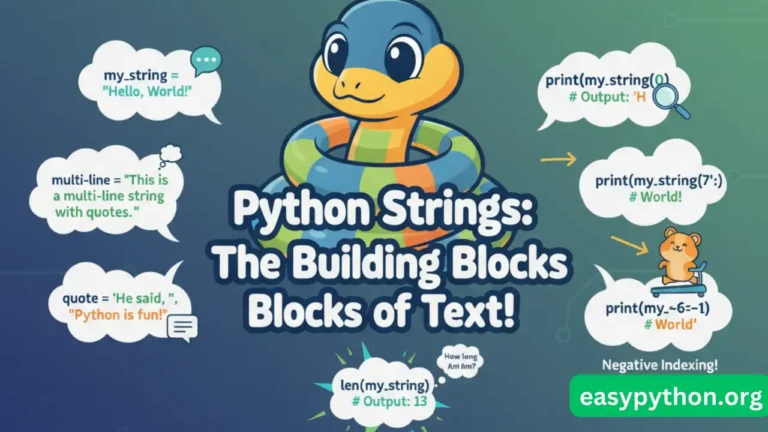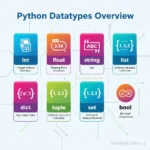Imagine you just joined a Python class, and the instructor says:
“Strings are just text, wrapped in quotes.”
Sounds simple, right? Wrong. 🤯 Strings in Python are like that one friend who looks chill at first, but the more you hang out, the more you realize they’ve got layers of drama, quirks, and hidden talents.
At its core, a Python string is a sequence of characters (letters, numbers, symbols, emojis — yes, even 🍕). You put them inside quotes ('hello', "world", or even """triple quotes""" for multiline vibes).
👉 If you’re new to Python, I’d highly recommend peeking at this Python datatypes overview before diving headfirst.
Python String Data Type Basics
Strings = text. Python treats them as immutable (fancy word: unchangeable).
Example:
name = "Python"
print(name)
# Output: PythonTry changing a single letter? Python will look at you like: “Nope, I’m immutable, darling.”
Why Strings Matter
- Printing messages (
print("Hello World")) - Taking user input
- Reading/writing files
- Formatting data for output
- Even passwords and usernames in your apps = strings
In short: If Python were a movie, strings are the main character, and everything else is just supporting cast.
Python String Slicing
Strings are sequences, so you can slice them like pizza slices.
text = "PythonRocks"
print(text[0:6]) # Output: Python
print(text[-5:]) # Output: Rockstext[0:6]→ starts at index 0, stops before 6text[-5:]→ counts backward from the end
Think of indexing like Netflix episodes: start at 0, not 1. Yeah, Python is that nerdy.
Common Python String Methods
Here’s the cheat-sheet every beginner needs:
.upper()→ YELLS YOUR TEXT.lower()→ whispers softly.strip()→ removes unwanted spaces (like cleaning your room).replace("old","new")→ relationship upgrade 😅.split()→ chops string into a list
Example:
quote = " Python is Fun! "
print(quote.strip()) # "Python is Fun!"
print(quote.upper()) # "PYTHON IS FUN!"👉 For more tools, check this Python built-in functions list.
Python String Methods Cheat Sheet
| Method | Description | Example |
|---|---|---|
capitalize() | Capitalizes first letter, rest lowercase | "hello".capitalize() → "Hello" |
casefold() | Aggressive lowercase (for comparisons) | "HELLO".casefold() → "hello" |
center(width[, fill]) | Centers string with padding | "cat".center(10, "-") → "---cat----" |
count(sub[, start, end]) | Counts occurrences of substring | "banana".count("a") → 3 |
encode(encoding, errors) | Encodes string into bytes | "hi".encode("utf-8") |
endswith(suffix[, start, end]) | Checks if string ends with substring | "python".endswith("on") → True |
expandtabs(tabsize=8) | Replaces tabs with spaces | "a\tb".expandtabs(4) |
find(sub[, start, end]) | Finds lowest index of substring | "python".find("th") → 2 |
format(*args, **kwargs) | String formatting | "{} loves {}".format("Bob","Python") |
format_map(mapping) | Format using dict mapping | "{x}".format_map({"x":10}) → "10" |
index(sub[, start, end]) | Like find() but raises error if not found | "abc".index("b") → 1 |
isalnum() | Checks alphanumeric only | "abc123".isalnum() → True |
isalpha() | Checks if only letters | "Python".isalpha() → True |
isascii() | Checks if all ASCII | "Py".isascii() → True |
isdecimal() | Checks if only decimals | "123".isdecimal() → True |
isdigit() | Checks if only digits | "²".isdigit() → True |
isidentifier() | Valid Python identifier? | "var_1".isidentifier() → True |
islower() | All lowercase? | "hello".islower() → True |
isnumeric() | Only numbers (includes fractions, etc.) | "⅓".isnumeric() → True |
isprintable() | Only printable characters? | "Hello!".isprintable() → True |
isspace() | Only whitespace? | " ".isspace() → True |
istitle() | Titlecase? | "Hello World".istitle() → True |
isupper() | All uppercase? | "HELLO".isupper() → True |
join(iterable) | Joins iterable into a string | ",".join(["a","b"]) → "a,b" |
ljust(width[, fill]) | Left-justifies string | "cat".ljust(10,"-") → "cat-------" |
lower() | Converts to lowercase | "HELLO".lower() → "hello" |
lstrip([chars]) | Strips left-side chars/spaces | " hi".lstrip() → "hi" |
maketrans(x, y, z) | Translation table | "abc".maketrans("a","x") |
partition(sep) | Splits into 3 parts (before, sep, after) | "a-b".partition("-") → ('a','-','b') |
removeprefix(prefix) | Removes prefix if present | "unhappy".removeprefix("un") → "happy" |
removesuffix(suffix) | Removes suffix if present | "reading".removesuffix("ing") → "read" |
replace(old, new[, count]) | Replaces substrings | "hello".replace("l","x") → "hexxo" |
rfind(sub[, start, end]) | Finds highest index of substring | "banana".rfind("a") → 5 |
rindex(sub[, start, end]) | Like rfind but raises error if not found | "banana".rindex("a") → 5 |
rjust(width[, fill]) | Right-justifies string | "cat".rjust(10,"-") → "-------cat" |
rpartition(sep) | Splits at last occurrence of sep | "a-b-c".rpartition("-") → ('a-b','-','c') |
rsplit(sep=None, maxsplit=-1) | Splits from right side | "a,b,c".rsplit(",",1) → ['a,b','c'] |
rstrip([chars]) | Strips right-side chars/spaces | "hi ".rstrip() → "hi" |
split(sep=None, maxsplit=-1) | Splits string into list | "a b c".split() → ['a','b','c'] |
splitlines([keepends]) | Splits by line breaks | "a\nb".splitlines() → ['a','b'] |
startswith(prefix[, start, end]) | Checks if starts with substring | "python".startswith("py") → True |
strip([chars]) | Removes both left & right chars/spaces | " hi ".strip() → "hi" |
swapcase() | Swaps cases | "Hello".swapcase() → "hELLO" |
title() | Converts to Title Case | "hello world".title() → "Hello World" |
translate(table) | Replaces using translation table | "abc".translate({"a":"x"}) |
upper() | Converts to uppercase | "hello".upper() → "HELLO" |
zfill(width) | Pads string with zeros on left | "42".zfill(5) → "00042" |
String Formatting in Python
1. Old School %
name = "Azeem Teli"
print("Hello %s!" % name)2. .format()
print("Hello {}, you are {} years old.".format("Azeem Teli", 25))3. F-Strings (Python 3.6+)
age = 30
print(f"Wow, you are {age} years old!")F-strings are like that cool cousin who makes everything effortless. Use them. Always.
Strings Are Immutable (But Why??)
Let’s say you try:
text = "Python"
text[0] = "J"Python: ❌ “Excuse me? I don’t do surgery on strings.”
Instead, create a new string:
new_text = "J" + text[1:]
print(new_text) # "Jython"This immutability keeps strings safe, fast, and memory-efficient.
Advanced Stuff: Escape Sequences & Raw Strings
Escape Sequences
Want to add special characters like \n (new line)?
poem = "Roses are red\nViolets are blue\nI love Python\nAnd so will you!"
print(poem)Raw Strings (r’…’)
Raw strings are like “don’t touch my backslashes”:
path = r"C:\Users\Name\Desktop"
print(path)Without r'', Python would start crying over \n.
Strings + Collections = Magic
Ever used strings with lists, tuples, sets, or dictionaries? Oh boy, they’re unstoppable.
Example:
words = "Python is awesome".split()
print(words) # ['Python', 'is', 'awesome']Boom. String converted into a list.
FAQs About Python Strings
What’s the difference between single, double, and triple quotes?
Nothing for single vs. double, but triple quotes let you write multi-line text.
Can strings store numbers?
Yes, but as text. "123" ≠ 123. (One is a string, one is an int).
Why are strings immutable?
Performance, memory safety, and preventing chaos. Imagine changing "hello" directly inside a dictionary key—Python says “No thanks.”
Final Thoughts
Strings are the bread and butter of Python programming. From "Hello World" to building full apps, you’ll trip over them everywhere. Master them early, and you’ll thank yourself later.
If you’re still wrapping your head around Python basics, check out this Python for beginners guide or even explore some Python books to level up.
And remember: Strings may look innocent, but they’ve got more drama than a Netflix series.





[…] Want a deeper look at strings and number conversions? Here’s a fun Python string tutorial to help you […]
[…] Wanna learn about Python strings being immovable divas? Here’s your backstage pass: Python String Data Type Tutorial. […]